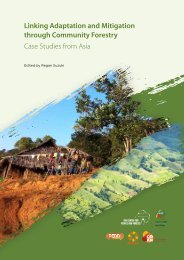Desktop Study on - Regional Climate Change Adaptation ...
Desktop Study on - Regional Climate Change Adaptation ...
Desktop Study on - Regional Climate Change Adaptation ...
Create successful ePaper yourself
Turn your PDF publications into a flip-book with our unique Google optimized e-Paper software.
<str<strong>on</strong>g>Desktop</str<strong>on</strong>g> <str<strong>on</strong>g>Study</str<strong>on</strong>g><br />
Provincial, Municipal and Barangay (village) Disaster<br />
Coordinating Councils (DCCs) (Asian Disaster<br />
Preparedness Center, 2003, Rincón and Virtucio,<br />
Jr, 2008). The NDCCs’ organizati<strong>on</strong>al network is<br />
illustrated in Figure 21.<br />
The Regi<strong>on</strong>al Disaster Coordinating Councils<br />
(RDCCs) facilitates activities of nati<strong>on</strong>al government<br />
agencies at the regi<strong>on</strong>al level. RDCCs do not have<br />
their own budget and can operate <strong>on</strong>ly through<br />
mutual coordinati<strong>on</strong> of the member agencies such as<br />
the Philippine Nati<strong>on</strong>al Police and the Metro Manila<br />
Development Agency. The RDCCs’ activities include<br />
establishment of a Regi<strong>on</strong>al Disaster Operati<strong>on</strong>s<br />
Center, Implementati<strong>on</strong> of guidelines within the<br />
regi<strong>on</strong>s set by the NDCC, and provisi<strong>on</strong> of advice to<br />
local-level disaster coordinating councils <strong>on</strong> disaster<br />
management. The local-level disaster coordinating<br />
councils are expected to carry out all the necessary<br />
activities at the respective levels, namely, provincial,<br />
city/municipal and barangay system levels.<br />
Gaps Identified<br />
World Bank’s study (2005) highlights that<br />
instituti<strong>on</strong>al setup in disaster management systems<br />
in the Philippines tend to focus <strong>on</strong> a reactive and<br />
post-disaster relief approach and short-term<br />
preparedness. To avoid disaster-pr<strong>on</strong>e c<strong>on</strong>diti<strong>on</strong>s, it<br />
is imperative to take a proactive approach such as<br />
integrati<strong>on</strong> of the threat of natural hazards into the<br />
development of l<strong>on</strong>g-term sustainable development<br />
and adequate land-use planning and c<strong>on</strong>structi<strong>on</strong>.<br />
The shortcomings of proactive approach are<br />
associated with a lack of a nati<strong>on</strong>al framework for<br />
comprehensive disaster risk management as policy<br />
support. The study defined key areas that have to<br />
be addressed for an integrated risk management<br />
within the necessary steps of risk identificati<strong>on</strong>, risk<br />
reducti<strong>on</strong>, and risk sharing and financing (World<br />
Bank, 2005). Further, the study suggested that such<br />
instituti<strong>on</strong>al changes would need to be accompanied<br />
by coordinating and implementing agencies, working<br />
in a participatory, instead of top-down approach.<br />
The participati<strong>on</strong> of all stakeholders in a bottomup<br />
approach will help to improve the resilience<br />
of the most vulnerable communities. Further, the<br />
study emphasized that since the Philippines still<br />
tends to rely <strong>on</strong> centralized top-down systems,<br />
local government units need to be encouraged to<br />
undertake respective bottom-up initiatives.<br />
Recent Projects<br />
UNDP, FAO, WHO, UN-Habitat, UNICEF, ILO, and<br />
UNFPA are implementing the three-year joint<br />
program (2007-2009) to strengthen the country’s<br />
instituti<strong>on</strong>al capacity to adapt to climate change, in<br />
collaborati<strong>on</strong> with UNEP, the Interagency Committee<br />
<strong>on</strong> <strong>Climate</strong> <strong>Change</strong>, d<strong>on</strong>ors and other partners<br />
working in the most disaster pr<strong>on</strong>e eastern seaboard.<br />
The program aims to achieve three outcomes in the<br />
areas of policy/planning/programming; capacity<br />
development of c<strong>on</strong>cerned nati<strong>on</strong>al government<br />
instituti<strong>on</strong>s and local governments and local higher<br />
educati<strong>on</strong>al instituti<strong>on</strong>s; and capacity development<br />
of communities to develop dem<strong>on</strong>strable climate<br />
change adaptati<strong>on</strong> measures. Specifically, three<br />
outcomes are climate risk reducti<strong>on</strong> mainstreamed<br />
into key nati<strong>on</strong>al and selected local development<br />
plans and processes; enhanced nati<strong>on</strong>al and<br />
local capacity to develop, manage and administer<br />
projects addressing climate change risks; and coping<br />
mechanisms improved through pilot adaptati<strong>on</strong><br />
projects.<br />
FAO has launched a two-year capacity building<br />
project at the community-level with a focus <strong>on</strong> the<br />
agricultural sector in January 2009. The project<br />
objective is to develop the capacity of the selected<br />
communities in the Bicol regi<strong>on</strong> to better prepare<br />
against natural disasters such as typho<strong>on</strong>s, floods<br />
and drought for improved livelihood and food<br />
security. In particular, it assists the small farmers,<br />
fisher folks and livestock raisers in enhancing the<br />
capacity to plan their producti<strong>on</strong> and marketing in<br />
accordance with the climatic, market and financial<br />
risks.<br />
SUMMARY OF IDENTIFIED<br />
KEY GAPS, CONSTRAINTS<br />
AND CHALLENGES<br />
Research Gaps<br />
There have not been much research focus <strong>on</strong> the<br />
large scale structural causes of vulnerability such as<br />
poverty, inequity, instituti<strong>on</strong>al and ec<strong>on</strong>omic barriers<br />
to development that undermine the enhancement<br />
of the ability of the farmers to cope with floods<br />
and water shortages. As indicated in the study of<br />
the Pantabangan-Carranglan Watershed (PCW),<br />
an ideal program for reducing the vulnerability of<br />
farmers, the most affected from climate change,<br />
should address structural improvement, such as the<br />
ability to gain access to cheaper alternative water<br />
sources, to engage in alternative cropping systems<br />
for their livelihoods, and to set in place systematic<br />
mechanisms for providing the farmers with technical<br />
and logistical assistance particularly designed for<br />
66

















